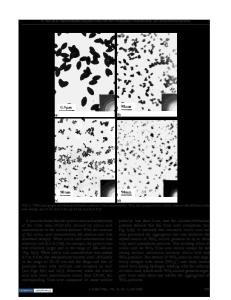Effect of processing parameters on anodic nanoporous tungsten oxide film structure and porosity for hydrogen detection
- PDF / 763,663 Bytes
- 9 Pages / 584.957 x 782.986 pts Page_size
- 111 Downloads / 2,700 Views
i Tian College of Material Science and Engineering, Beijing University of Technology, Beijing 100124, People’s Republic of China (Received 16 September 2013; accepted 21 November 2013)
Nanoporous tungsten oxide films were synthesized by an anodic oxidation process in aqueous NaF/HF electrolytes. The tungsten films were deposited by the radio frequency magnetron sputtering method on sapphire substrates, and the anodic oxidation process was conducted in a dual-electrode reaction chamber with graphite electrode. The effects of processing parameters (anodic voltage, time, temperature, and the operation distance) on the morphology and porosity of the synthesized films were investigated experimentally. The samples were characterized by x-ray diffraction and scanning electron microscopy. The results showed that the pore diameter and porosity increased gradually with increasing anodic voltage, whereas the “wall” of the pore was subjected to electric breakdown at 60 V, and the pore diameter and porosity decreased. The pore diameter and porosity showed an early increased and later decreased state as the operation time and distance are increased. The sensitive response in the resistive method is reaction-dominated type and is exhibited as a linear relationship as a function of hydrogen gas concentration. The response toward 500 ppm hydrogen in air is up to 15.1 with a response time of 10 min at 200 °C. I. INTRODUCTION
Hydrogen is used as a clean renewable source in various fields, such as chemical production,1,2 fuel cell technology,3 and rocket engine.4 Therefore, sensing and monitoring of hydrogen leakage is a nonnegligible issue for safety consideration. Tungsten oxide is considered as one of the most promising candidates for hydrogen sensitive materials because of its interesting structural and defective properties. Various structural thick or thin films of tungsten oxides were prepared and investigated by a number of methods including chemical vapor deposition,5 hydro- or solvothermal,6,7 thermal evaporation,8 magnetron sputtering,9 evaporation, anodic oxidation,10 and so on. The performance of tungsten oxide gas sensors can be significantly enhanced by increasing the surface area, which provides more surface adsorption sites for the reaction of analyte and oxygen atoms. Accordingly, anodic oxidation is a promising process for fabricating well-defined thin nanoporous films due to their low cost to build uniform controllable morphologies and large area oxide film. Typically, several successful anodization conditions for synthesizing a uniform nanoporous WO3 layer have been reported. Ou et al.11 prepared a WO3 nanoporous a)
Address all correspondence to this author. e-mail: [email protected] DOI: 10.1557/jmr.2013.369 166
J. Mater. Res., Vol. 29, No. 1, Jan 14, 2014
http://journals.cambridge.org
Downloaded: 09 Jul 2014
network by anodization of a RF-sputtered tungsten film deposited on fluoride doped tin oxide conductive glass; the crystalline nanoporous network with thicknesses ranging from 0.6 to 1 lm exhibited enhanced electr
Data Loading...











